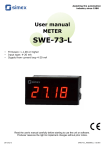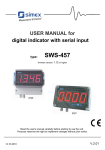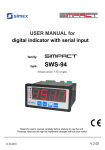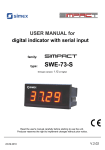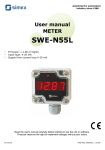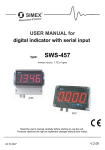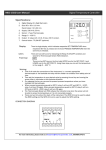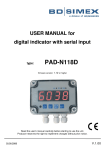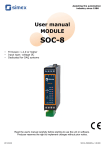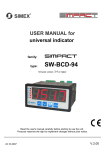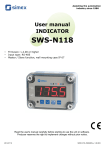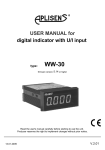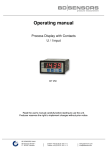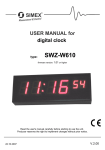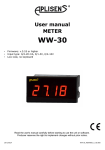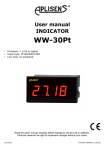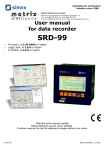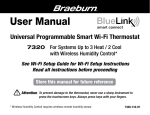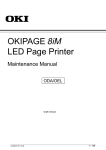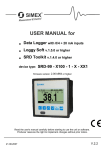Download APLISENS Ltd. PMS-920/I/Z
Transcript
APLISENS Ltd. 7, Morelowa Str., 03-192 Warsaw, Poland; www.aplisens.pl USER MANUAL Digital indicator with relay outputs PMS-920/I/Z firmware version: x.02 or higher Read the user's manual carefully before starting to use the unit. Producer reserves the right to implement changes without prior notice. Warsaw 22.06.2006 V.1.0 Digital indicator with relay outputs PMS-920/I/Z CONTENTS 1. BASIC REQUIREMENTS AND USER SAFETY.......................................................................................3 2. GENERAL CHARACTERISTICS..............................................................................................................4 3. TECHNICAL DATA...................................................................................................................................4 4. DEVICE INSTALLATION..........................................................................................................................6 4.1. UNPACKING....................................................................................................................................6 4.2. ASSEMBLY......................................................................................................................................6 4.3. CONNECTION METHOD................................................................................................................8 4.4. MAINTENANCE.............................................................................................................................11 5. FRONT PANEL DESCRIPTION..............................................................................................................11 6. PRINCIPLE OF OPERATION.................................................................................................................12 6.1. MEASUREMENT MODE...............................................................................................................12 6.2. CONTROL OF THE RELAY OUTPUTS.........................................................................................13 6.2.1. One threshold mode.............................................................................................................14 7. DEVICE PROGRAMMING......................................................................................................................15 7.1. PROGRAMMING MENU...............................................................................................................15 7.2. PARAMETERS EDITION...............................................................................................................16 7.2.1. Numeric parameters ............................................................................................................16 7.2.2. Switch parameters (“LIST” type) ..........................................................................................16 7.3. MENU DESCRIPTION...................................................................................................................17 7.3.1. “rEL1” , “rEL2” menu.............................................................................................................17 7.3.2. “inPt” menu...........................................................................................................................19 7.3.3. ”SECu” menu........................................................................................................................21 7.3.4. ”rS” menu..............................................................................................................................21 7.3.5. ”SErv” menu.........................................................................................................................21 7.4. MENU STRUCTURE.....................................................................................................................22 8. THE ALARM LED...................................................................................................................................23 9. OVER-CURRENT PROTECTION...........................................................................................................23 10. DISPLAYED VALUES CALCULATION................................................................................................23 10.1. ADDITIONAL CALCULATIONS (USED CONVERSION CHARACTERISTIC).............................23 10.1.1. Linear characteristic............................................................................................................24 10.1.2. Square characteristic..........................................................................................................24 10.1.3. Square root characteristic...................................................................................................25 10.1.4. User defined characteristic.................................................................................................25 10.2. EXAMPLES OF CALCULATIONS...............................................................................................26 11. THE MODBUS PROTOCOL HANDLING..............................................................................................29 11.1. LIST OF REGISTERS..................................................................................................................29 11.2. TRANSMISSION ERRORS DESCRIPTION................................................................................31 11.3. EXAMPLES OF QUERY/ANSWER FRAMES.............................................................................31 12. DEFAULT AND USER'S SETTINGS LIST............................................................................................34 2 Digital indicator with relay outputs PMS-920/I/Z Explanation of symbols used in the manual: - This symbol denotes especially important guidelines concerning the installation and operation of the device. Not complying with the guidelines denoted by this symbol may cause an accident, damage or equipment destruction. IF THE DEVICE IS NOT USED ACCORDING TO THE MANUAL THE USER IS RESPONSIBLE FOR POSSIBLE DAMAGES. - This symbol denotes especially important characteristics of the unit. Read any information regarding this symbol carefully 1. BASIC REQUIREMENTS AND USER SAFETY - The manufacturer is not responsible for any damages caused by inappropriate installation, not maintaining the proper technical condition and using the unit against its destination. - Installation should be conducted by qualified personnel . During installation all available safety requirements should be considered. The fitter is responsible for executing the installation according to this manual, local safety and EMC regulations. - The unit must be properly set-up, according to the application. Incorrect configuration can cause defective operation, which can lead to unit damage or an accident. - If in the case of a defect of unit operation there is a risk of a serious threat to the safety of people or property additional, independent systems and solutions to prevent such a threat must be used. - The unit uses dangerous voltage that can cause a lethal accident. The unit must be switched off and disconnected from the power supply prior to starting installation of troubleshooting (in the case of malfunction). - Neighbouring and mating equipment must meet the requirements of appropriate standards and regulations concerning safety and be equipped with adequate anti-overvoltage and anti-interference filters. - Do not attempt to disassemble, repair or modify the unit yourself. The unit has no user serviceable parts. Units, in which a defect was stated must be disconnected and submitted for repairs at an authorized service centre. - In order to minimize fire or electric shock hazard, the unit must be protected against atmospheric precipitation and excessive humidity. - Do not use the unit in areas threatened with excessive shocks, vibrations, dust, humidity, corrosive gasses and oils. - Do not use the unit in explosion hazard areas. 3 Digital indicator with relay outputs PMS-920/I/Z - Do not use the unit in areas with significant temperature variations, exposed to condensation or icing. - Do not use the unit in areas exposed to direct sunlight. - Make sure that the ambient temperature (e.g. inside the control box) does not exceed the recommended values. In such cases forced cooling of the unit must be considered (e.g. by using a ventilator). The unit is designed for operation in an industrial environment and must not be used in a household environment or similar. 2. GENERAL CHARACTERISTICS The PMS-920/I/Z controller is equipped with one measurement input (current input) with user selected range 0-20mA or 4-20mA and a standard resistor protection circuit. Displayed values range can be selected by user, from -999 to 9999, plus decimal point. Additionally the PMS-920/I/Z allows user to select a conversion characteristic of several kinds: linear, square, square root, and user defined (max.20 points length). The device is equipped with sensor supply output and one (or two) relay outputs which can be loaded max. 1A/250V. Optionally PMS-920/I/Z can be equipped with RS 485 interface. The controller can be ordered in two power supply versions. The device has 4 buttons being used for main presets programming. PMS-920/I/Z can be used for controlling and regulation of processes need proportional and threshold control like: temperature processes (heating or cooling), valves controlling or other. 3. TECHNICAL DATA Power supply voltage (depending on version) External fuse (required) Power consumption 230 V AC ± 10%; 50 ÷ 60 Hz 24 V DC (not separated) T - type, max. 2 A max. 1,5 VA @ 230V AC max. 3,5 W @ 24V DC Measurement input current range: 0÷20 mA, 4÷20 mA overload protected, maximum input current about 35 mA measurement input resistance: 100 Ω accepted prolonged input overload: 20% Outputs relay: sensor power supply: 1 or 2 NO, 1A/250V AC (cos ϕ = 1) 21V DC ± 5V / max. 25 mA (100 mA for 24V DC power supply), not stabilized, not separated from measurement inputs Display range -999 ÷ 9999, plus decimal point Current measurement accuracy ± 0,25% ± one digit (for 0÷20 mA range) Communication interface (optional) Baud rate RS 485, 8N1 / Modbus RTU, not separated 1200 bit/s ÷ 19200 bit/s 4 Digital indicator with relay outputs PMS-920/I/Z Display (depending on version) Standard version: LED, 4 digit, 20mm height, red IP 65 version: 5 digit, 9mm height, red Protection level IP 65 (from front, after using waterproof cover) IP 40 (from front) IP 20 (housing and connection clips) Housing type Housing material Housing dimensions Panel cutout Assembly depth Panel thickness panel NORYL - GFN2S E1 72 x 36 x 97 mm 66,5 x 32,5 mm 102 mm max. 5 mm Operating temperature Storage temperature Humidity Altitude 0°C to +50°C -10°C to +70°C 5 to 90% no condensation up to 2000 meters above sea level Screws tightening max. torque 0,5 Nm Max. connection leads diameter 2,5 mm2 Safety requirements according to: PN-EN 61010-1:1999 + PN-EN 61010-1/A2:1999 installation category: II pollution degree: 2 voltage in relation to ground: 300V AC EMC insulation resistance: >20MΩ insulation strength between power supply and input/output terminal: 1min. @ 2300V insulation strength between relays terminal: 1min. @ 1350V PN-EN 61326:2003 This is a class A unit. In housing or a similar area it can cause radio frequency interference. In such cases the user can be requested to use appropriate preventive measures. 5 Digital indicator with relay outputs PMS-920/I/Z 4. DEVICE INSTALLATION The unit has been designed and manufactured in a way assuring a high level of user safety and resistance to interference occurring in a typical industrial environment. In order to take full advantage of these characteristics installation of the unit must be conducted correctly and according to the local regulations. - Read the basic safety requirements on page 3 prior to starting the installation. - Ensure that the power supply network voltage corresponds to the nominal voltage stated on the unit’s identification label. - The load must correspond to the requirements listed in the technical data. - All installation works must be conducted with a disconnected power supply. - Protecting the power supply clamps against unauthorized persons must be taken into consideration. 4.1. UNPACKING After removing the unit from the protective packaging, check for transportation damage. Any transportation damage must be immediately reported to the carrier. Also, write down the unit serial number on the housing and report the damage to the manufacturer. Attached with the unit please find: - assembly brackets - 2 pieces, - warranty, - user’s manual for PMS-920/I/Z unit (device) 4.2. ASSEMBLY - The unit is designed for mounting indoor inside housings (switchbox, switchboard) assuring appropriate protection against electric impulse waves. Metal housing must be connected to the grounding in a way complying with the governing regulations. - Disconnect the power supply prior to starting assembly. - Check the correctness of the performed connections prior to switching the unit on. In order to assembly the unit, a 66,5 x 32,5 mm panel cutout (Figure 4.1) must be prepared. The thickness of the material of which the panel is made must not exceed 5mm. When preparing the cutout take the grooves for catches located on both sides of the housing into consideration (Figure 4.1). Place the unit in the cutout inserting it from the front side of the panel, and then fix it using the brackets (Figure 4.2). The minimum distances between assembly holes’ axes - due to the thermal and mechanical conditions of operation - are 91 mm x 57mm (Figure 4.3). 6 Digital indicator with relay outputs PMS-920/I/Z 66,5 mm 8 mm 32,5 mm 8 mm 8 mm 8 mm max. 5 mm 1 mm 1 mm Figure 4.1. Panel cutout dimensions 8,5 mm 16 mm 92 mm 5 mm 12 mm 10 mm Figure 4.2. Installing of brackets, and dimensions of connectors. 57 mm 91 mm Figure 4.3. Minimum distances between axes of devices when assembly of a number of units 7 Digital indicator with relay outputs PMS-920/I/Z 4.3. CONNECTION METHOD Caution - Installation should be conducted by qualified personnel . During installation all available safety requirements should be considered. The fitter is responsible for executing the installation according to this manual, local safety and EMC regulations. - The unit is not equipped with an internal fuse or power supply circuit breaker. Because of this an external time-delay cut-out fuse with minimal possible nominal current value must be used (recommended bipolar, max. 2A) and a power supply circuit-breaker located near the unit. In the case of using a monopolar fuse it must be mounted on the phase cable (L). - The power supply network cable diameter must be selected in such a way that in the case of a short circuit of the cable from the side of the unit the cable shall be protected against destruction with an electrical installation fuse. - Wiring must meet appropriate standards and local regulations and laws. - In order to secure against accidental short circuit the connection cables must be terminated with appropriate insulated cable tips. - Tighten the clamping screws. The recommended tightening torque is 0.5 Nm. Loose screws can cause fire or defective operation. Over tightening can lead to damaging the connections inside the units and breaking the thread. - In the case of the unit being fitted with separable clamps they should be inserted into appropriate connectors in the unit, even if they are not used for any connections. - Unused clamps (marked as n.c.) must not be used for connecting any connecting cables (e.g. as bridges), because this can cause damage to the equipment or electric shock. - If the unit is equipped with housing, covers and sealing packing, protecting against water intrusion, pay special attention to their correct tightening or clamping. In the case of any doubt consider using additional preventive measures (covers, roofing, seals, etc.). Carelessly executed assembly can increase the risk of electric shock. - After the installation is completed do not touch the unit’s connections when it is switched on, because it carries the risk of electrical shock. 8 Digital indicator with relay outputs PMS-920/I/Z Due to possible significant interference in industrial installations appropriate measures assuring correct operation of the unit must be applied. To avoid the unit of improper indications keep recommendations listed below. - Avoid common (parallel) leading of signal cables and transmission cables together with power supply cables and cables controlling induction loads (e.g. contactors). Such cables should cross at a right angle. Contactor coils and induction loads should be equipped with anti-interference protection systems, e.g. RC-type. Use of screened signal cables is recommended. Signal cable screens should be connected to the earthing only at one of the ends of the screened cable. In the case of magnetically induced interference the use of twisted couples of signal cables (so-called “spirals”) is recommended. The spiral (best if shielded) must be used with RS-485 serial transmission connections. In the case of interference from the power supply side the use of appropriate antiinterference filters is recommended. Bear in mind that the connection between the filter and the unit should be as short as possible and the metal housing of the filter must be connected to the earthing with largest possible surface. The cables connected to the filter output must not run in parallel with cables with interference (e.g. circuits controlling relays or contactors). max. 2 mm Connections of power supply voltage and measurement signals are executed using the screw connections on the back of the unit’s housing (Figure 4.4 - 4.6). 6-7 mm Figure 4.4. Method of cable insulation replacing and cable terminals 9 Digital indicator with relay outputs PMS-920/I/Z (optional) R2 + Us - Power supply (depend on version) 1 (optional) +21V ±5V RS - 485 Imax* = 25mA GND DATA+ 2 DATA- 13 14 16 17 18 19 20 3 4 6 7 8 9 10 n.c. n.c. *For power supply 24V DC Imax = 100mA n.c. GND + 0-20mA 4-20mA R1 Figure 4.5. Terminals description All connections must be made while power supply is disconnected ! R2 (optional) L N 1 2 R1 13 14 3 4 FUSE FUSE Depend on version 230V AC or 24V DC L N Figure 4.6. Connection of power supply and relays 10 Digital indicator with relay outputs PMS-920/I/Z 4.4. MAINTENANCE The unit does not have any internal replaceable or adjustable components available to the user. Pay attention to the ambient temperature in the room where the unit is operating. Excessively high temperatures cause faster ageing of the internal components and shorten the fault-free time of unit operation. In cases where the unit gets dirty do not clean with solvents. For cleaning use warm water with small amount of detergent or in the case of more significant contamination ethyl or isopropyl alcohol. Using any other agents can cause permanent damage to the housing. Product marked with this symbol should not be placed in municipal waste. Please check local regulations for disposal and electronic products. 5. FRONT PANEL DESCRIPTION Symbols and functions of pushbuttons ESC MENU ENTER Symbol used in the manual: [ESC/MENU] Functions: • Enter to main menu ( press and hold by at least 2 sec.) • Exit the current level and Enter to previous menu (or measure mode) • Cancel the changes made in parameter being edited Symbol used in the manual: [ENTER] Functions: • Start to edit the parameter • Enter to the sub-menu, • Confirmation of changes made in parameter being edited Symbol used in the manual: [^] [v] Functions: • Change of the present menu, • Modification of the parameter value, • Change of the display mode. 11 Digital indicator with relay outputs PMS-920/I/Z 6. PRINCIPLE OF OPERATION After turning the power supply on, device ID and software version are showed on the display, next the controller goes to the measurement mode. 6.1. MEASUREMENT MODE In the measure mode, the measurement results, converted over selected characteristic, are displayed on the display. The measurement range equal to the nominal range is called: nominal measurement range, and the measurement range equal to the extended nominal range is called: permissible measurement range (Figure 6.1, 6.2). ”Lo r” parameter ”Hi r” parameter nominal measurement range 4 mA 20 mA permissible measurement range Figure 6.1. Definitions of measurement ranges in mode 4 ÷ 20mA If the result of measurement exceeds the permissible measurement range, AL diode lights and warning ”-Hi-” or ”-Lo-” is displayed rather than input signal, depends on exceeded value (see description of “Lo r” i “Hi r” parameters, paragraph ”inPt” menu). The warning can be effect of measurement circuit malfunction. In that case “-Lo-” means shortcut and “-Hi-” means break of measurement circuit. ”Hi r” parameter nominal measurement range 0 mA 20 mA permissible measurement range Figure 6.2. Definitions of measurement ranges in mode 0 ÷ 20mA 12 Digital indicator with relay outputs PMS-920/I/Z In the measurement mode user can check main thresholds values. After pressing [^] or [v] button, name of the threshold (”rEL1” or ”rEL2”) and his value will be displayed on the display in alternating mode. If [^] or [v] will be pressed in 5 sec again, the next threshold will be displayed, else the device comes back to the measurement mode. If a free access is enabled (parameter ”AccE” = on), user can change the value of particular threshold pressing button [ENTER] (see: PARAMETERS EDITION). Input type, range of displaying values, characteristic of conversion, decimal point position and measure filtering ratio, are user configurable parameters. All accessible parameters can be changed by entering the menu (see: DEVICE PROGRAMMING). Use the local keyboard or the remote controller to do it. (Note: all parameters can be remote changed via RS-485 interface). Configuration of the device (via menu or RS 485 interface) do not stops measures. 6.2. CONTROL OF THE RELAY OUTPUTS The control of the object (measured signal) is realized via relay outputs. Front panel LEDs named „R” indicates the state of particular relay output. If device is not equipped with one or more relay outputs, menus refer to this relays are available, but apply to LED indicators only. In such case LEDs indicates exceeding of particular thresholds. Modes of the control can be changed depend on the values of parameters “SEtP”, “SEt2”, “HYSt”, “modE”, “t on”, “toFF”, “unit” and “AL”. Depend on “modE” parameter, relays can be not used or controlled over one or two thresholds values. If one threshold is used (Figure 6.3) the relay can be turned on (“modE” = ”on”) or off (“modE” = ”oFF”) when the input signal value is contained in zone A. state of relay/LED ”SEtP” parameter zone B zone A measure ”HYSt” parameter Figure 6.3. One threshold control of the relay outputs and LEDs R1÷R4 13 Digital indicator with relay outputs PMS-920/I/Z 6.2.1. One threshold mode Figure 6.4 presents the principle of relay outputs operation for one threshold mode, and an example values of other parameters. displayed value a) zone A tB tA B A tC c) C e) D DOFF DON relay state (modE = on t on = 0 toFF = 0) relay state (modE = oFF t on = 0 toFF = 0) relay state (modE = on t on > 0 toFF > 0) d) “SEtP” parameter (expected signal value) tD BOFF B ON zone B b) measured signal relay state (modE = oFF t on > 0 toFF > 0) “HYSt” parameter (allowed signal deviation) time closed opened time closed opened time closed opened time closed “t on” parameter “toFF” parameter opened time “toFF” parameter “t on” parameter Description: A, B, C, D - points where measured signal exceeds border values (expected value ± allowed deviation) BON ,BOFF ,DON ,DOFF - relays state changes moments: (for “t on” > 0, “toFF” > 0) tA , tB , tC , tD , - time periods while input signal is in zone A or zone B Figure 6.4. Principle of LED/relay output operation for one threshold mode Parameter “SetP” sets a threshold of the relay, and parameter “HYSt” sets a hysteresis of the relay (Figure 6.4 a). The relay can change his state only when input value exceeds (over or under) border value and tA ,tB ,tC ,tD times (Figure 6.4) are bigger than the time defined by parameters “t on”, “toFF” and “unit”. Border values means values equal threshold+hysteresis and threshold-hysteresis respectively. If “t on” and “toFF” parameters are set to “0”, then the relay state will be changed as soon as input value exceeds any of the border values (see points A and C, Figure 6.4 a, b, c). If values of “t on” or/and “toFF” are positive, then relay state will be turned on if the input value exceeds the border values and stay bigger (or lower) during at least “t on” (see points BON, DON, Figure 6.4 a, d, e). Similarly, the relay will be turned off if time “toFF” elapse since the input signal value exceeds any of the border values (see points BOFF, DOFF, Figure 6.4 a, d, e). 14 Digital indicator with relay outputs PMS-920/I/Z If tA ,tB ,tC or tD (when input signal stay in zone A or zone B) are lower than parameters “t on” or “toFF”, the relay will not change his state (see points A and C, Figure 6.4 a, d, e). The state of relay output while the input value exceeds the border values (points A, B, C, D) is described by parameter “modE”. The relay can be turned on (“modE” = ”on”), or turned off (“modE” = ”oFF”) when input signal value is contained in zone A (Figure 6.4 a). The parameter “AL” allow user to set the relay output behaviour in critical situations (e. g. Input values exceeds permissible measurement range). User can select that the relays will be turned on, turned off,or not changed in critical situations. All parameters connected with relay outputs are described in paragraph ”rEL1”, ”rEL2” menu. 7. DEVICE PROGRAMMING The device menu allow user to set all parameters connected to operation of measurement input, control modes, critical situations behaviour, communication via RS-485 and access settings. The meaning of the particular parameters is described in paragraph MENU DESCRIPTION. Some of the parameters can be accessed without menu entering (quick view mode). After pressing [^] or [v] button, name of the threshold (”rEL1” or ”rEL2”) and his value will be displayed on the display in alternating mode. If [^] or [v] will be pressed in 5 sec again, the next threshold will be displayed, else the device comes back to the measurement mode. If a free access is enabled (parameter ”AccE” = on), user can change the value of particular threshold pressing button [ENTER] (see: PARAMETERS EDITION). If particular parameter has been changed and confirmed in quick view mode, its new value is displayed in alternating mode with parameter name by few seconds. Confirmed changes may be checked or user can switch viewed parameter pressing [^] or [v] button. 7.1. PROGRAMMING MENU To enter main menu (being in the measurement mode) operator must to press and hold at least 2 sec. [ESC/MENU] button. If the user password is defined (see parameter “Scod“, menu ”SECU”), operator have to enter correct one before proceeding to menu options . Entering of the passwords is similar to the edition of numeric parameters (see: PARAMETERS EDITION ), however presently editing digit is showed only on the display, other digits are replaced by “-” sign. After entering of last digit of the password first menu position will be displayed (if the password is correct) or warning ”Err” in other case. 15 Digital indicator with relay outputs PMS-920/I/Z Pay attention when device parameters are being changed. If it is possible, turn off controlled installation (machine). Functions of the buttons while sub-menu and parameters choice: Selection of sub-menu or parameter for editing. Name of selected item (submenu or parameter) is displayed. ENTER ESC MENU Operation of [ENTER] button depend on present menu position: • if the name of some sub-menu is displayed - enter this sub-menu; name of the first parameter (or next level sub-menu) is displayed, • if the name of some parameter is displayed - enter the edition of this parameter; present value of the parameter is displayed, [ESC/MENU] button allow user to exit present menu level and goes to upper level menu (or measurement mode). After about 1 min. since last use of the buttons, device exits the menu mode and returns to the measurement mode (only if no parameters are in editing mode). 7.2. PARAMETERS EDITION To start edition of any parameter user should select name of desired one using [^] [v] buttons and then [ENTER]. 7.2.1. Numeric parameters Numeric parameters constitute a series of digits that form a number in decimal format. Entering a new parameter value consists of changing the values of selected digits within the allowable range (using the [^], [v] keys). Some numeric parameters can take negative values). In such cases the "-" mark can be selected on the first decimal position of the parameter. 7.2.2. Switch parameters (“LIST” type) Switch parameters can be described as a sets of values (a lists) out of which only one of the options available on the list can be selected for the given parameter. Options of switching parameter are selected using [^], [v] keys. 16 Digital indicator with relay outputs PMS-920/I/Z Functions of buttons when editing numeric and switching parameters: Change of current (flashing) digit value while editing numeric parameter, or value of switch parameter. ENTER ESC MENU Pressing [ENTER] causes by switching edited digit or finishing of edition (if last digit or list-type parameter is edited). After that ask ”Set?” is displayed. If [ENTER] is pressed again, than new value is stored in EEPROM, in other case changes are cancelled. Pressing this button operator can cancel the changes done up to now (if they were not approved by [ENTER] button after the ”SEt?” ask) and come back to menu 7.3. MENU DESCRIPTION “- - - -” Password checking. If any password different from „0000” is set, than every enter to main menu follows the entering of password. If entered password is correct first menu position will be displayed else warning ”Err”, and unit returns to measurement mode. Due to on 7 segment display it is impossible to show all ASCII symbols, some of them are exchanged by special symbols. For example the letter “m” is displayed as “ “. Although special symbols are used by the device, normal letters are used in instruction to made its easier to read (example: “modE”). 7.3.1. “rEL1” , “rEL2” menu This menu contains options of configuration of operation of relays R1, R2. Principle of the relays operation is described in paragraph CONTROL OF THE RELAY OUTPUTS. If device is not equipped with one or more relay outputs, menus refer to this relays are available, but apply to LED indicators only. In such case LEDs indicates exceeding of particular thresholds. “SEtP” - first threshold of the relay (range -999 ÷ 9999). Negative values can be input by selecting a “-” sign on first digit (to change value use [^] and [v] buttons). Threshold is the medium value of relay hysteresis. “HYSt” - Hysteresis of relay (range 0 -999). Full hysteresis of the relay is equal to 2x “HYSt” parameter. The relay state can change when an input signal is out of threshold-hysteresis to threshold+hysteresis zone. 17 Digital indicator with relay outputs PMS-920/I/Z Presented parameters should be set to ensure that SEtP + HYSt and SEtP - HYSt do not exceeds the measure range. “modE” - relay operation mode: “noAC” - the relay is not active (permanent turned off) “on” - the relay is turned ON when input signal exceeds SEtP + HYSt value, and is turned off back when the input signal became lower than SEtP – HYSt, “oFF” - the relay is turned OFF when input signal exceeds SEtP + HYSt value, and is turned on back when the input signal became lower than SEtP – HYSt, “modb” - the relay is controlled via RS-485 interface, independently on the input signal. • • LEDs light when relays are closed, independently of relays' mode. When power supply decay, unit do not store relays state selected by RS 485 interface. “t on” - turn on delay time, the relay is turned on with delay equal “t on” if the input value exceeds appropriate border value (defined with threshold and hysteresis), at least “t on” time. “t on” range 0 ÷ 99.9, defined with 0.1 sec. resolution. Unit of this parameter is set by “unit” parameter. “toFF” - turn off delay time, the relay is turned off with delay equal “toFF” if the input value exceeds appropriate border value (defined with threshold and hysteresis), at least “toFF” time. “toFF” range 0 ÷ 99.9, defined with 0.1 sec. resolution. Unit of this parameter is set by “unit” parameter. If time when the input signal exceeds some border value is shorter than “t on” or “toFF” time, the relay do not change his state (see paragraph: CONTROL OF THE RELAY OUTPUTS). “unit” - unit of time for “t on” i “toFF” parameters. Can be set on one of two values: “min” “SEC” - minutes, - seconds. “AL”- This parameter defines the relay reaction when some critical situations occurs: “noCH” “on” “oFF” 18 - relay do not change his state, - relay will be turned on, - relay will be turned off. Digital indicator with relay outputs PMS-920/I/Z • • If option “noCH” is selected for “AL” parameter, behaviour of the relay may depend on “FiLt” parameter in some cases. If “FiLt” is set to big value and the input current drops, result value of the measure will change slow, causes of turning on or off relay due to thresholds values. The critical situation is slowly detected, so it is not possible to predict the relay state in that situations. If parameter „AL” = „on”, the relay will be turned on in the critical situations, even if his parameter “modE” = ”noAC”. 7.3.2. “inPt” menu This menu presets the measurement input: “tYPE" - type of the input / sensor. This parameter can be set to values: ”0-20”, “4-20” ”CHAr” - current inputs of 0÷20mA or 4÷20mA of measurement range respectively. Displayed values are defined by parameters “Lo C”,”Hi C” (or by user defined characteristic points) and parameter ”Pnt”. - this option presets type of the conversion characteristic, and can be set to ”Lin” “Sqr” “Sqrt” “5 Pt” “10Pt” “20Pt” - linear - square - square root When one of those characteristics is chosen display range is defined by “Lo C” and “Hi C”. User defined characteristic. This characteristic is defined by 5, 10 or 20 segments, respectively of selected option. Range of displayed values is defined using “Lo C”, “P 0.05” ... “P 0.95”, “Hi C” parameters. The process of displayed result calculation is described in details in DISPLAY VALUES CALCULATION paragraph. ”FiLt” ”Pnt” - this parameter sets filtration rate. It can be set to values from 0 (no filtration ) to 5 (strongest filtration – time window about 2 sec). - decimal point position. It can be set to one of: “ 0”, “ 0.0”, “ 0.00”, “0.000” Decimal point position is changed by [^], [v] buttons. “Lo C” These parameters describe the displayed values, referred to different “P0.05” measurement results. If input type is set to 4-20 mA (0-20mA) “Lo C” : parameter defines the value displayed when input current is equal 4 mA (0mA), : and “Hi C” parameter defines the value displayed for 20 mA of input current. “P0.95 “Hi C” Options like “P 0.XX” define value displayed, while measurement result is equal to particular percentage value of selected measurement range, for example: if range is 4-20 mA, parameter “P 0.30” defines value displayed while current is equal to 8,8 mA. 19 Digital indicator with relay outputs PMS-920/I/Z Particular options “P 0.XX” are available (in menu) only while specific user characteristic is selected. E.g. when user characteristic uses 5 segments then only “Lo C”, “P 0.20”, “P 0.40”, “P 0.60”, “P 0.80” and “Hi C” are available. If linear, square or square root characteristic is selected, then parameters “Lo C” and “Hi C” are only available. All mentioned parameters can be set in range -999 ÷ 9999. Negative values can be set by entering '-' sign on the first position (by use of [^], [v] buttons). “Lo r”, ”Hi r” - These parameters define the expansion of nominal range in percent. They determine the permissible range of input currents (Figure7.1). The permissible range allow user to exceed the nominal range of input current. If input value is contained in the permissible range a proper result is displayed. If input current exceeds this range (defined by “Lo r” and “Hi r”), “-Lo-” or “-Hi-” warning is displayed depend on input current value. ”Lo r” = 75,0% (3 mA) ”Hi r” = 5,0 % (1 mA) nominal measurement range (4-20mA) Imin 0 4 1 Imax 20 21 22 [ mA ] permissible measurement range display message ”-Lo-” measurement result is displayed regardless on nominal range exceeding display message ”-Hi-” Figure 7.1 Example of definition of permissible range of input currents “Lo r” and “Hi r” parameters (“4-20” mode) The “Lo r” parameter is important if input is set to “4-20” mode only, and determines lower border of the permissible range. If input is set to “0-20” mode, lower border of the permissible range is always 0mA. If input is set to “4-20” mode, the lower border is calculated due to expression: Imin = 4 mA - 4 mA × “Lo r” %. The “Lo r” value can be set from 0 to 99.9%. Parameter “Hi r” determines the upper border of the permissible range accordingly to the expression (for both “0-20”i “4-20”modes): Imax = 20 mA + 20 mA × “Hi r” %. 20 Digital indicator with relay outputs PMS-920/I/Z The value of “Hi r” can be set from 0 to 19.9% In example no 1 of the DISPLAY VALUES CALCULATION paragraph the procedure of the permissible input range determining is presented in details. 7.3.3. ”SECu” menu This menu contains presets connected with availability of other parameters : “AccE” “Scod” - this option permits user (”on”) or prohibits (”oFF”) to modify the thresholds of the relays without knowledge about user password (see: MEASUREMENT MODE). - user password (4-digits number). If this parameter is set at value “0000”, user password is turned off. If the user do not remember his password, the access to the menu is possible by the “one-use password”. To get this password please contact witch Marketing Division. Please set new user password immediately after use of the “one-use password” - see “Scod” parameter. The “one-use password” can be used one time only, it is impossible to use it again! The “one-use password” can be restored by Service Division only. 7.3.4. ”rS” menu This menu is connected with RS-485 interface, and sets his properties: ”Addr” - this parameter defines the address of the device, accordingly to Modbus protocol. It can be set in range from 0 to 199. If the value 0 is set then device, responds to frames with address 255 (FFh). ”bAud” - this parameter determines RS-485 interface baud rate. It can be set to one of 5 possible values: ”1.2”, ”2.4”,”4.8”, ”9.6”, ”19.2”, which respond to the baud rates of 1200, 2400, 4800, 9600, 19200 bit/s respectively. ”mbAc” - this parameter sets the access to the configuration registers of the device. Possible values: ”on” - configuration registers can be set via RS-485 interface, ”oFF” - configuration registers can not be set via RS-485 interface. The access to registers no 02h cant be denied by ”mbAc” parameter (see: LIST OF REGISTERS ). 7.3.5. ”SErv” menu This menu contains the parameters for authorized service only. To enter this menu proper service password must be entered. Improper settings can causes of damage of the device. 21 Digital indicator with relay outputs PMS-920/I/Z 7.4. MENU STRUCTURE 22 Digital indicator with relay outputs PMS-920/I/Z 8. THE ALARM LED The ALARM LED (AL) is turned on when input current is out of the permissible input range. See parameters: “tyPE”, “Lo r” and “Hi r” in paragraph „InPt” menu. 9. OVER-CURRENT PROTECTION The input of the device is equipped with over-current protection circuit. This circuit protects the standard resistor to damage. Maximum input current is set to 35mA. Activity of protection is being signalised via message “Hot” on the display, and activation of alarm state in controller (relays in their alarm states, works accordingly to their settings “AL”). When temperature of the standard resistor falls, the protection circuit will turn off himself automatically, and the device will measure the input current again. Due to thermal phenomenon in the standard resistor, precision of the measurement may be lower, during few minutes (up to the standard resistor temperature will falls to the environment temperature). 10. DISPLAYED VALUES CALCULATION The first step to compute the result of measure is the calculation of the normalized result (it means result of 0-1 range). To do it, the begin of the input range (0 mA for 0-20mA range, and 4mA for 4-20mA range) must be subtracted from measured value. Next, received result must be divided by the width of the input range ( it means 20mA for 0-20mA range, and 16mA for 4-20mA range). So normalized result can be expressed by expressions: I inp.−4 16 I inp. I n= 20 I n= for 4 ÷ 20 mA range for 0 ÷ 20 mA range where Iinp. Means input current (in mA), and In – normalized result. If measured value exceeds the nominal input range (0-20mA or 4-20mA), and do not exceed the permissible input range, then received normalized In result will exceed 0-1 range, e.g. input range 4-20 mA, input current = 3 mA – the normalized result is equal -0,0625, and for input current = 22 mA, the normalized result is equal 1,125. In such cases presented expressions are still correct. 10.1. ADDITIONAL CALCULATIONS (USED CONVERSION CHARACTERISTIC) The manner of the additional computation of the displayed result depends on selected conversion characteristic. All presented charts are connected with the input range 4 - 20 mA. 23 Digital indicator with relay outputs PMS-920/I/Z 10.1.1. Linear characteristic The normalized result is converted by fixed coefficients determined by “Lo C” and “Hi C” parameters (when the normalized results is equal 0, then value “Lo C” is displayed, and when the normalized results is equal 1, then value “Hi C” is displayed). Expression presented below shows the manner of result calculation: W = I n × "Hi C"−"Lo C" "Lo C" , where W means the displayed value. The value of the “Lo C” parameter can be higher than the value of “Hi C” parameter. In such a case, for an increasing value of input current the displayed value decreases. Lo C Displayed value Displayed value Hi C Hi C Lo C 0 4 8 12 Input current [mA] 16 20 0 4 8 12 Input current [mA] 16 20 Figure. 10.1 Normal („Lo C” < ”Hi C) and inverted („Lo C” > ”Hi C) characteristic 10.1.2. Square characteristic The normalized result is squared and further conversion is done as for linear characteristic. Conversion is made accordingly with the expression: 2 W =I n × "Hi C"−"Lo C" "Lo C" , where W means the displayed value. Hi C Displayed value Displayed value Lo C Lo C Hi C 0 4 8 12 16 Input current [mA] 20 0 4 8 12 16 Input current [mA] 20 Figure. 10.2 Normal („Lo C” < ”Hi C) and inverted („Lo C” > ”Hi C) characteristic 24 Digital indicator with relay outputs PMS-920/I/Z 10.1.3. Square root characteristic The normalized result is rooted and further conversion is done as for linear characteristic. Conversion is made accordingly with the expression: W = I n × "Hi C" −"Lo C" "Lo C" , where W means the displayed value. Showed above expression is not valid when normalized result is negative. It is possible for 4-20 mode only. In this case (I n<0) the displayed result is equal “Lo C” (see graphs below). Lo C Displayed value Displayed value Hi C Lo C Hi C 0 4 8 12 16 Input current [mA] 20 0 4 8 12 16 Input current [mA] 20 Figure. 10.3 Normal („Lo C” < ”Hi C) and inverted („Lo C” > ”Hi C) characteristic 10.1.4. User defined characteristic User characteristics are defined by user using 5, 10 or 20 connected linear segments (it means using 6, 11 or 21 points – see graph). Due to the normalized result In , the device computes specific segment, e.g. for 10-segment characteristic and In = 0.65, the segment defined by points “P 0.60” and “P 0.70” will be chosen. Let's mark those points as PL (point low) i PH (point high) - in this example PL= “P 0.60,” and PH = “P 0.70.”, and the normalized result In for the point PL as Ip (in this example Ip = In(PL) = 0.6). The displayed result is calculated accordingly to the expression: W = N × I n −I p × PH− PL PL where N mean number of segments (5, 10 or 20). If the normalized result exceeds the user defined characteristic values, then specific utmost segment, defined by two next points, is used for calculations. If characteristic from figure below is used, and if In>1 then segment defined by points PL = “P 0.80” and PH = “Hi C” will be used (Ip = 0,8). 25 Digital indicator with relay outputs PMS-920/I/Z Normalized measurement In (for 4-20 mA range) 0,4 0,6 0,8 0 0,2 1 5-elements characteristic Displayed value P0.60 Y (PH) P0.20 Y (PL) P0.40 „Lo C” Prąd wejściowy [mA] P0.80 „Hi C” 0 4 8 12 16 20 Input current [mA] Figure. 10.4 Example of user defined characteristic 10.2. EXAMPLES OF CALCULATIONS Example 1: Selection of the permissible input range (“4-20” mode) If in “4-20” mode the user sets “Lo r” = 20,0% and “Hi r” = 10,0%, then permissible input currents range will be equal: 3,2 mA ÷ 22 mA. Lower border of the range is the result of calculations: 4 mA - 4 mA × 20%, and the higher : 20 mA + 20 mA × 10%. Example 2: The normalized In result calculation Let the input mode = 4-20 mA. The normalized In result is calculated accordingly to the expression on page 23, so if Iin = 10 mA then 10 mA - 4 mA = 6 mA, and this result should be divided by the width of input range (16 mA). Finally the normalized result: In = 6/16 = 0,375. In case when input current exceeds nominal measurement range, calculations are similar. For example if input current is equal 2,5 mA then In = (2,5 - 4)/16 ≅ -0,0938, and if input current is equal 20,5 mA then In = (20,5 - 4)/16 ≅ 1,0313. Example 3: The linear characteristic Let the input mode = 4-20 mA, and parameters “Lo C” and “Hi C” equal to -300 and 1200 respectively. The calculations will be done for there different input currents from example 2. 26 Digital indicator with relay outputs PMS-920/I/Z a) Iin =10 mA and In = 0,375 Accordingly to expression on page 24 for linear characteristic: 0,375 × [1200 -(- 300)] ≅ 562 and next, the “Lo C” value is added to the result , so the displayed value: W ≅ 562 + (-300) = 262 b) Iin = 2,5 mA and In = -0,0938. W ≅ -441. c) Iin = 20,5 mA and In = 1,0313. W ≅ 1247. Example 4: The square characteristic Let the input mode = 4-20 mA, and parameters “Lo C” and “Hi C” equal to -300 and 1200 respectively. The calculations will be done for there different input currents from example 2. a) Iin =10 mA and In = 0,375 Accordingly to expression on page 24 for linear characteristic: (0,375)2 × [1200 -(- 300)] ≅ 211. and next, the “Lo C” value is added to the result , so the displayed value: W ≅ 211 + (-300) = -89 b) Iin = 2,5 mA and In = -0,0938. W ≅ -287. c) Iin = 20,5 mA and In = 1,0313. W ≅ 1295. Example 5: The square root characteristic Let the input mode = 4-20 mA, and parameters “Lo C” and “Hi C” equal to -300 and 1200 respectively. The calculations will be done for there different input currents from example 2. a) Iin =10 mA and In = 0,375 Accordingly to expression on page 25 for linear characteristic: sqrt(0,375) × [1200 -(- 300)] ≅ 919. and next, the “Lo C” value is added to the result , so the displayed value: W ≅ 919 + (-300) = 619 b) Iin = 2,5 mA and In = -0,0938 , normalized result is negative , so the displayed value is equal to “Lo C” parameter: W ≅ “Lo C” = -300. c) Iin = 20,5 mA and In = 1,0313. W ≅ 1223. 27 Digital indicator with relay outputs PMS-920/I/Z Example 6: The user defined characteristic Let the input mode = 4-20 mA, and the user selected the 10 segment characteristic. To do this it is necessary to enter “Lo C”, “P 0.10”, “P 0.20”, ..., “P 0.90”, “Hi C”. coordinates. The calculations will be done for three different input currents from example 2, so in calculations some of the segments will be used only. Let the following points will be given: “Lo C” = -50, “P 0.10” = -30, .... “P 0.30” = 30, “P 0.40” = 80, ... “P 0.90” = 900, “Hi C” = 820. Additionally all other points must to be defined and stored in the device memory. a) Iin =10 mA and In = 0,375 The segment defined by “P 0.30” and “P 0.40” for this In will be selected. Accordingly to expressions given for user defined characteristic (see page 25) PL = ”P 0.30” = 30, PH = “P 0.40” = 80 and Ip = 0,3 , the displayed value : W = N × I n −I p × PH −PL PL= =10 × 0,375 −0,3 × 80 −3030 ≃ 67 b) Iin = 2,5 mA and In = -0,0938, because of the normalized In value is lower than 0, the segment defined by ”Lo C” and “P 0.10” will be selected. PL = ”Lo C” = -50, PH = “P 0.10” = -30 and Ip = 0. For these values the displayed value W ≅ -69. c) Iin = 20,5 mA and In = 1,0313. , because of the normalized In value is higher than 1, the segment defined by ”P 0.90” and “Hi C” will be selected. PL = ”P 0.90” = 900, PH = “Hi C” = 820 and Ip = 0,9. For these values the displayed value W ≅ 795. 28 Digital indicator with relay outputs PMS-920/I/Z 11. THE MODBUS PROTOCOL HANDLING Transmission parameters: 1 start bit, 8 data bits, 1 stop bit, no parity control Baud rate: selectable from: 1200 to 19200 bits/second Transmission protocol: MODBUS RTU compatible The device parameters and measurement result are available via RS-485 interface, as HOLDING-type registers of Modbus RTU protocol. The registers (or groups of the registers) can be read by 03h function, and wrote by 06h (single registers) accordingly to Modbus RTU specification. Maximum group size for 03h functions can not exceeds 5 registers (for single frame). The device interprets the broadcast messages, but then do not sends the answers. 11.1. LIST OF REGISTERS Register Write Range 01h No -999 ÷ 9999 Register description Current measurement value (no decimal point) 02h Yes 0÷7 State of the relays and alarm LED (binary format) (1 - on, 0 - off): 00000000 00000cba a - relay R1; b - relay R2; c - alarm LED; If written, only a, b bits are important (others are ignored) these bits allows user to control the relays via RS-485 interface 04h Yes 0÷1 “tyPE” parameter in “InPt” menu (nominal input range). 0 - 0-20 mA range; 1 - 4-20 mA range 05h Yes 1÷6 “CHAr” parameter in “InPt” menu (characteristic type) 1 - linear ; 2 - 5-segments ; 3 - 10-segments ; 4 - 20-segments; 5 - square; 6 - square root; 06h Yes 0÷5 “FiLt” parameter in “InPt” menu (measurement filtering rate) 07h Yes 1÷4 “Pnt ” parameter in “InPt” menu (decimal point position) 1 - “ 0”; 2 - “ 0.0”; 3 - “ 0.00”; 4 - “0.000” 08h Yes -999 ÷ 9999 “Lo C” parameter in “InPt” menu, no decimal point included “Hi C” parameter in “InPt” menu, no decimal point included 09h Yes -999 ÷ 9999 0Ah Yes 0 ÷ 999 “Lo r” parameter in “InPt” menu, in 0,1% 0Bh Yes 0 ÷ 199 “Hi r” parameter in “InPt” menu, in 0,1% 10h Yes -999 ÷ 9999 “SEtP” parameter in “rEL1” menu, no decimal point included 11h Yes 0 ÷ 999 “HySt” parameter in “rEL1” menu, no decimal point included 29 Digital indicator with relay outputs PMS-920/I/Z Register Write Range 12h Yes 0÷3 13h Yes 0 ÷ 999 “t on” parameter in “rEL1” menu, expressed in tenth of seconds or tenth of minutes depend on “unit” parameter - register no. 15h) 14h Yes 0 ÷ 999 “toFF” parameter in “rEL1” menu, expressed in tenth of seconds or tenth of minutes depend on “unit” parameter - register no. 15h) 15h Yes 0÷1 “unit” parameter in “rEL1” menu (the time unit of R1 relay); 0 - seconds; 1 - minutes 16h Yes 0÷2 “AL” parameter in “rEL1” menu (the state of R1 relay, while critical situation occurs); 0 - no changes; 1 - on; 2 - off 18h Yes -999 ÷ 9999 “SEtP” parameter in “rEL2” menu, no decimal point included 19h Yes 0 ÷ 999 “HySt” parameter in “rEL2” menu, no decimal point included 1Ah Yes 0÷3 “modE” parameter in “rEL2” menu (operation mode of R2 relay) 0 - no active; 1 - “on” mode; 2 - “oFF” mode; 3 - the relay controlled via RS-485 interface 1Bh Yes 0 ÷ 999 “t on” parameter in “rEL2” menu, expressed in tenth of seconds or tenth of minutes depend on “unit” parameter - register no. 1Dh) 1Ch Yes 0 ÷ 999 “toFF” parameter in “rEL2” menu, expressed in tenth of seconds or tenth of minutes depend on “unit” parameter - register no. 1Dh) 1Dh Yes 0÷1 “unit” parameter in “rEL2” menu (the time unit of R2 relay); 0 - seconds; 1 - minutes 1Eh Yes 0÷2 “AL” parameter in “rEL2” menu (the state of R2 relay, while critical situation occurs); 0 - no changes; 1 - on; 2 - off 20h1 Yes 0 ÷ 199 Device address 21h No 00A7h Device identification code (ID) 22h2 Yes 0÷4 “bAud” parameter in “rS” menu (baud rate); 0 - 1200 baud; 1 - 2400 baud; 2 - 4800 baud; 3 - 9600 baud; 4 - 19200 baud 23h3 Yes 0÷1 “mbAc” parameter in “rS” menu (permission to write registers via RS-485 interface); 0 - write denied ; 1 - write allowed 24h Yes 0÷1 “AccE” parameter in “SECU” menu (permission to change of the thresholds without knowledge of the user password); 0 - changes denied; 1 - changes allowed 38h Yes -999 ÷ 9999 “Lo C” parameter in “inPt” menu, no decimal point included (copy of 08h register) 39h 3Ah Yes Yes -999 ÷ 9999 -999 ÷ 9999 . . . . . . . . . “P0.05” parameter in “inPt” menu, no decimal point included “P0.10” parameter in “inPt” menu, no decimal point included 4Bh Yes -999 ÷ 9999 30 Register description “modE” parameter in “rEL1” menu (operation mode of R1 relay) 0 - no active; 1 - “on” mode; 2 - “oFF” mode; 3 - the relay controlled via RS-485 interface . . . “P0.95” parameter in “inPt” menu, no decimal point included Digital indicator with relay outputs PMS-920/I/Z 1 2 3 Register Write Range 4Ch Yes -999 ÷ 9999 Register description “Hi C” parameter in “inPt” menu, no decimal point included (copy of 09h register) - after writing to register no 20h the device responds witch an “old” address in the message. - after writing to register no 22h the device responds with the new baud rate. - the value of the “mbAc” parameter is also connected to write to this register, so it is possible to block a writes, but impossible to unblock writes via RS-485 interface, The unblocking of the writes is possible from menu level only. 11.2. TRANSMISSION ERRORS DESCRIPTION If an error occurs while write or read of single register, then the device sends an error code according to Modbus RTU specifications (example message no 1). Error codes: 01h - illegal function (only functions 03h, 06h and 10h are available), 02h - illegal register address 03h - illegal data value 08h - no write permission ( see: “mbAc” parameter) A0h - exceed of upper border of input range 60h - exceed of lower border of input range A0h and 60h codes can appear only during reg. 01h is reading by 03h function (read of a single register). 11.3. EXAMPLES OF QUERY/ANSWER FRAMES Examples apply for device with address 1. All values are represent hexadecimal. Field description: ADDR Device address on modbus network FUNC Function code REG H,L Starting address (address of first register to read/write, Hi and Lo byte) COUNT H,L No. of registers to read/write (Hi and Lo byte) BYTE C Data byte count in answer frame DATA H,L Data byte (Hi and Lo byte) CRC L,H CRC error check (Hi and Lo byte) 31 Digital indicator with relay outputs PMS-920/I/Z 1. Read of the displayed value (measurement), the device address = 01h: ADDR FUNC 01 03 REG H,L 00 COUNT H,L 01 00 CRC L,H 01 D5 CA a) The answer (we assume that input current is not out of range): ADDR FUNC BYTE C 01 03 02 DATA H,L 00 CRC L,H FF F8 04 DATA H, L - displayed value = 255, no decimal point. Decimal point position can be read from reg. 07h. b) The answer (if an error occur): ADDR FUNC 01 ERROR 83 CRC L,H 60 41 18 ERROR - error code = 60h, bottom border of the measurement range is exceeded 2. Read of ID code ADDR FUNC REG H,L 01 03 00 ADDR FUNC BYTE C 01 03 02 COUNT H,L 21 00 CRC L,H 01 D4 00 The answer: DATA H,L 00 CRC L,H A7 F9 FE DATA - identification code (00A7h) 3. Change of the device address from 1 to 2 (write to reg. 20h) ADDR FUNC 01 06 REG H,L 00 20 DATA H,L 00 DATA H - 0 DATA L - new device address (2) 32 02 CRC L,H 09 C1 Digital indicator with relay outputs PMS-920/I/Z The answer (the same as the message): ADDR FUNC 01 06 REG H,L 00 DATA H,L 20 00 CRC L,H 02 09 C1 4. Change of baud rate of all devices connected to the net (BROADCAST message). ADDR FUNC 00 06 REG H,L 00 COUNT H,L 22 00 CRC L,H 04 29 D2 DATA H - 0 DATA L - 4, new baud rate 19200 baud Device do not reply to BROADCAST-type messages. 5. Read of the registers 1 and 2 in one message (example of writing a number of registries in one frame): ADDR FUNC 01 03 REG H,L 00 COUNT L COUNT H,L 01 00 CRC L,H 03 54 0B - the count of being read registers (max. 5) The answer: ADDR FUNC BYTE C 01 03 04 DATA H1, L1 DATA H2, L2 DATA H1,L1 DATA H2,L2 00 00 0A 01 CRC L,H 1B F1 - reg. 01h (10 - displayed value ”1.0”),, - reg. 02h (0 - relay R1 closed ),, There is no full implementation of the Modbus Protocol in the device. The functions presented above are available only. 33 Digital indicator with relay outputs PMS-920/I/Z 12. DEFAULT AND USER'S SETTINGS LIST Parameter Description Default value User's value Desc. page Parameters of relay R1 operation (“rEL1” menu) SEtP Relay R1 threshold 6.50 17 HYSt Hysteresis of relay R1 0.00 17 modE Operation mode of relay R1 on 18 t on Turn on delay of relay R1 0.1 18 toFF Turn off delay of relay R1 0.1 18 unit Unit of “t on”, “toFF” parameters of relay R1 SEC 18 AL Reaction for critical situation of relay R1 oFF 18 Parameters of relay R2 operation (“rEL2” menu) SEtP Relay R2 threshold 9.50 17 HYSt Hysteresis of relay R2 0.00 17 modE Operation mode of relay R2 on 18 t on Turn on delay of relay R2 0.1 18 toFF Turn off delay of relay R2 0.1 18 unit Unit of “t on”, “toFF” parameters of relay R2 SEC 18 AL Reaction for critical situation of relay R2 oFF 18 Configuration of measurement input (“inPt” menu) tYPE Input mode „4-20” 19 CHAr Conversion characteristic mode FiLt Filtering ratio Lin 19 0 19 Pnt Decimal point position 0.00 19 Lo C Minimum displayed value (for nominal range) 4.0 19 P0.05 Value displayed for selected point of user characteristic 0.00 19 P0.10 see above 0.00 19 P0.15 see above 0.00 19 P0.20 see above 0.00 19 P0.25 see above 0.00 19 P0.30 see above 0.00 19 P0.35 see above 0.00 19 P0.40 see above 0.00 19 P0.45 see above 0.00 19 34 Digital indicator with relay outputs PMS-920/I/Z User's value Desc. page Parameter Description Default value P0.50 see above 0.00 19 P0.55 see above 0.00 19 P0.60 see above 0.00 19 P0.65 see above 0.00 19 P0.70 see above 0.00 19 P0.75 see above 0.00 19 P0.80 see above 0.00 19 P0.85 see above 0.00 19 P0.90 see above 0.00 19 P0.95 see above 0.00 19 20.00 19 Hi C Maximum displayed value (for nominal range) Lo r Extension of the bottom of the nominal input range 5.0 (%) 20 Hi r Extension of the top of the nominal input range 5.0 (%) 20 Settings of access to the configuration parameters (“SECu” menu) AccE Permission to changes of relays thresholds without of the user password knowledge Addr Device address bAud mbAc oFF 21 RS 485 interface configuration (menu “rS”) 0 21 Baud rate 9.6 21 Blocking of access to the configuration registers on 21 35




































